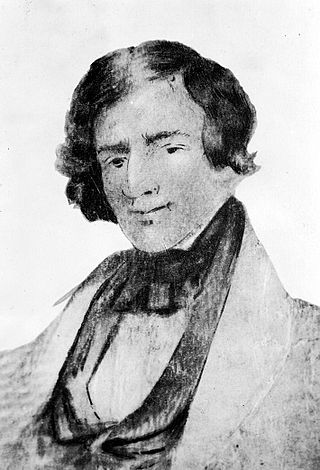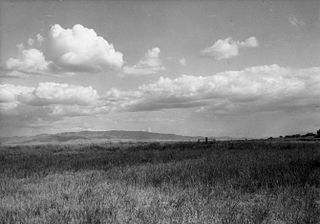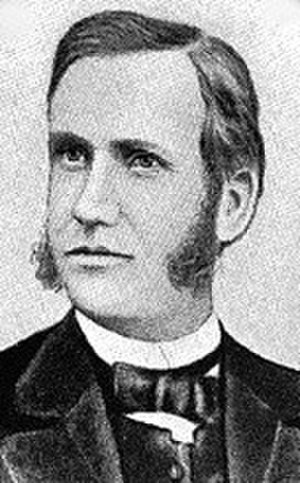
The Oregon Trail was a 2,170-mile (3,490 km) east–west, large-wheeled wagon route and emigrant trail in the United States that connected the Missouri River to valleys in Oregon Territory. The eastern part of the Oregon Trail crossed what is now the states of Kansas, Nebraska, and Wyoming. The western half crossed the current states of Idaho and Oregon.

Jedediah Strong Smith was an American clerk, transcontinental pioneer, frontiersman, hunter, trapper, author, cartographer, mountain man and explorer of the Rocky Mountains, the Western United States, and the Southwest during the early 19th century. After 75 years of obscurity following his death, Smith was rediscovered as the American whose explorations led to the use of the 20-mile (32 km)-wide South Pass as the dominant route across the Continental Divide for pioneers on the Oregon Trail.

James Felix Bridger was an American mountain man, trapper, Army scout, and wilderness guide who explored and trapped in the Western United States in the first half of the 19th century. He was known as Old Gabe in his later years. He was from the Bridger family of Virginia, English immigrants who had been in North America since the early colonial period.

A mountain man is an explorer who lives in the wilderness and makes his living from hunting and trapping. Mountain men were most common in the North American Rocky Mountains from about 1810 through to the 1880s. They were instrumental in opening up the various emigrant trails allowing Americans in the east to settle the new territories of the far west by organized wagon trains traveling over roads explored and in many cases, physically improved by the mountain men and the big fur companies, originally to serve the mule train-based inland fur trade.

South Pass is a route across the Continental Divide, in the Rocky Mountains in southwestern Wyoming. It lies in a broad high region, 35 miles (56 km) wide, between the nearly 14,000 ft (4,300 m) Wind River Range to the north and the over 8,500 ft (2,600 m) Oregon Buttes and arid, saline near-impassable Great Divide Basin to the south. The Pass lies in southwestern Fremont County, approximately 35 miles (56 km) SSW of Lander.

Fort Hall was a fort in the Western United States that was built in 1834 as a fur trading post by Nathaniel Jarvis Wyeth. It was located on the Snake River in the eastern Oregon Country, now part of present-day Bannock County in southeastern Idaho. Wyeth was an inventor and businessman from Boston, Massachusetts, who also founded a post at Fort William, in present-day Portland, Oregon, as part of a plan for a new trading and fisheries company. In 1837, unable to compete with the powerful British Hudson's Bay Company, based at Fort Vancouver, Wyeth sold both posts to it. Great Britain and the United States both operated in the Oregon Country in these years.

Marcus Whitman was an American physician and missionary. He is most well-known for leading American settlers across the Oregon Trail, unsuccessfully attempting to Christianize the Cayuse Indians, and was subsequently killed by the Cayuse Indians in a event known as the 1847 Whitman massacre, over a misunderstanding, resulting in the beginning of the Cayuse war (1847-1855).

Henry Harmon Spalding (1803–1874) and his wife Eliza Hart Spalding (1807–1851) were prominent Presbyterian missionaries and educators working primarily with the Nez Perce in the U.S. Pacific Northwest. The Spaldings and their fellow missionaries were among the earliest Americans to travel across the western plains, through the Rocky Mountains and into the lands of the Pacific Northwest to their religious missions in what would become the states of Idaho and Washington. Their missionary party of five, including Marcus Whitman and his wife Narcissa and William H. Gray, joined with a group of fur traders to create the first wagon train along the Oregon Trail.
The enterprise that eventually came to be known as the Rocky Mountain Fur Company was established in St. Louis, Missouri, in 1822 by William Henry Ashley and Andrew Henry. Among the original employees, known as "Ashley's Hundred," were Jedediah Smith, who went on to take a leading role in the company's operations, and Jim Bridger, who was among those who bought out Smith and his partners in 1830. It was Bridger and his partners who gave the enterprise the name "Rocky Mountain Fur Company."

Across the Wide Missouri is a 1951 American Technicolor Western film based on historian Bernard DeVoto's eponymous 1947 book. The film dramatizes an account of several fur traders and their interaction with the Native Americans.

Stephen Hall L. Meek was a fur trapper and guide in the American west, most notably a guide on a large wagon train that used a trail known as the Meek Cutoff. A native of Virginia, both he and his younger brother Joseph Meek would spend their lives as trappers west of the Rocky Mountains.

William Lewis Sublette, also spelled Sublett, was an American frontiersman, trapper, fur trader, explorer, and mountain man. After 1823, he became an agent of the Rocky Mountain Fur Company, along with his four brothers. Later he became one of the company's co-owners, utilizing the riches of the Oregon Country. He helped settle and improve the best routes for migrants along the Oregon Trail.

Oregon pioneer history (1806–1890) is the period in the history of Oregon Country and Oregon Territory, in the present day state of Oregon and Northwestern United States.

Robert Stuart was a Scottish-born, Canadian and American fur trader, best known as a member of the first European-American party to cross South Pass during an overland expedition from Fort Astoria to Saint Louis in 1811. He was a member of the North West Company (NWC) until recruited by John Jacob Astor to develop the new Pacific Fur Company, which was based at Fort Astoria, on the coast of present-day Oregon. Astor intended the venture to develop a continent-wide commercial empire in fur trading.

Thomas Fitzpatrick was an American fur trader, Indian agent, and mountain man. He trapped for the Rocky Mountain Fur Company and the American Fur Company. He was among the first white men to discover South Pass, Wyoming. In 1831, he found and took in a lost Arapaho boy, Friday, who he had schooled in St. Louis, Missouri; Friday became a noted interpreter and peacemaker and leader of a band of Northern Arapaho.

Pierre's Hole is a shallow valley in the western United States in eastern Idaho, just west of the Teton Range in Wyoming. At an elevation over 6,000 feet (1,830 m) above sea level, it collects the headwaters of the Teton River, and was a strategic center of the fur trade of the northern Rocky Mountains. The nearby Jackson's Hole area in Wyoming is on the opposite side of the Tetons.

John Turner was an American fur trapper and guide who first entered Oregon Country in 1828 and became an early resident of the Willamette Valley. Later he moved to California where he was part of the second attempt to rescue the Donner Party.
Hiram Scott was an American mountain man, trapper, and pelt trader who trapped and took part in expeditions throughout the western United States during the 1820s. Born in Missouri, Scott joined the Rocky Mountain Fur Company in 1822 and took part in the first fur trade expedition at the Great Salt Lake in Utah. He died at age 23 near a cliff along the North Platte River in Nebraska which was named in his honor. The circumstances leading to his demise have given rise to many diverse accounts and theories.

Moses Harris, also known as Black Harris, was a trapper, scout, guide, and mountain man. He participated in expeditions across the Continental Divide and to the Pacific Ocean through the Rocky and Cascade Mountains. He rescued westward-bound pioneers. Harris spoke the Shoshoni language.


















